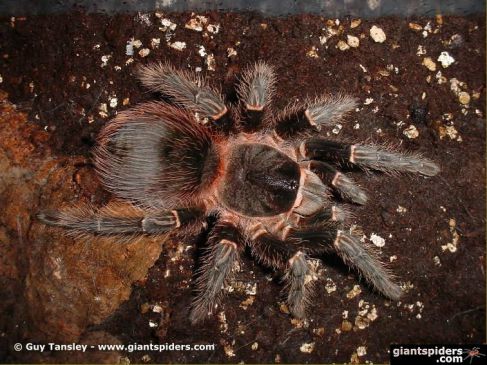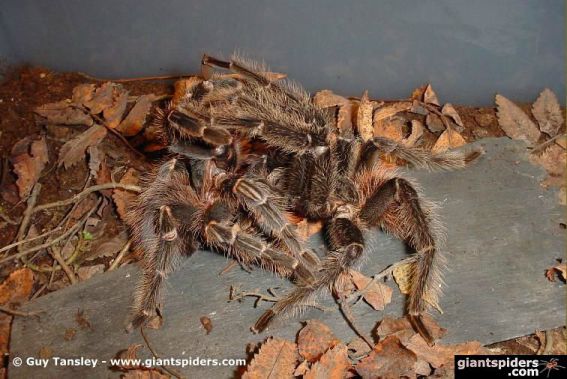
Breeding Lasiodora parahybana
Guy Tansley
I received a mature male L. parahybana from Mark Kent at the end of June 1994 and after giving it some time to settle, he successfully mated with my large female on the 1st of July.
A few days earlier the female was re-housed in a large permanent container for mating and, soon after arriving, the male was placed in her previous container. This produced some interesting behaviour from the male as he immediately began his courtship signalling on touching the females’ web. This smaller tank was placed inside the females and she responded to his vibrations by rapidly drumming with her forelegs. This continued through the night so the next morning he was introduced. Again he began to signal on contact with her web and she replied by slightly drumming with her palps, enticing him closer. He gradually moved onto the tank wall and eventually settled on a piece of vertical cork bark. On removing his box, the female became active and (as expected), began to climb the tank walls. The lid was partially replaced to prevent her escape but she eventually returned to the floor, drumming to the male and heading towards him. He continued vibrating his body until she was very close and sensing this, he changed his courtship behaviour and began reaching towards her with his front legs and slapping the bark with his palps. She took a while to respond but eventually climbed up the bark until she finally touched his front legs and he immediately moved in and began stroking her legs with his. She eagerly opened her chelicerae and he tried to engage her fangs with his tibial hooks. They slowly moved down the bark and he successfully secured her fangs then reaching underneath her, he inserted his right palpal bulb. She characteristically collapsed back on her abdomen and he removed his palp and a slight scuffle followed. They parted and he made a sharp exit up the bark and scrambled out of the tank while she quietly moved back to the floor. The females’ epigynum was very swollen after mating.
After pairing, the male was replaced in the females old tank but this time he spent all of the time on the tank walls and never ventured onto the floor as if apprehensive to meet the female. Therefore he was re-housed in a clean tank where he settled quickly.
Five days later the male was discovered building the beginnings of a new sperm web and this was completed 3 hours later. The second pairing was attempted two days later.
After being introduced he again signalled on touching her web but she remained still while he continued to vibrate his body between long periods of stillness. On the fourth attempt, the female suddenly jumped as if she'd been frightened and he moved slightly. This procedure continued again and again with her jumping and the male slowly moving away and after becoming restless, he was removed.
A possible explanation of the males’ unwillingness to mate could be that when he signalled she replied by jumping, this was telling him that she didn't want to mate. On their first encounter, she drummed her eagerness to him which encouraged him to mate but the second time she reacted totally different. Several more attempts were made over the following days but the female always behaved in the same manner and the male always moved away.
Over the following two weeks, the females appetite was insatiable and she took all food offered and her abdomen increased in size. Three months later, on October 2nd, she finally laid her eggs. A few days previously, she was seen wandering round the tank, occasionally digging the substrate, until she finally chose the egg laying sight in the fork of a large branch in her tank. Egg sac construction followed (temperature: 78oF, humidity: 65% -70%):
10.00: Started to lay down the fine silk in the depression in the substrate, concentrating on the circular floor area. This silk was laid down in short dabbing movements instead of the usual sweeping motion. By altering her spinning in this manner, the silk had a slight wool-like appearance which made it very soft. This continued throughout the day with her rest periods becoming progressively shorter.
15:00: Spinning of the floor area was now almost continuous, her rests very short and the silk very dense and a brilliant white colour.
17:55: Actual egg laying began. Standing on the tips of all the legs and the tip of her abdomen touching the ground, a large amount of yellow/white liquid ran from the epigynum to form a large puddle on the silken cup. The eggs then followed this liquid, flowing in a continual yellow stream while the abdomen became progressively shrivelled. The rapid pumping of the heart on top of the abdomen could clearly be seen.
18:00: The flow of the eggs eased to a trickle.
18:21: The egg laying complete, she started to spin fine silk over the egg mass, proceeding very gently, taking great care not to touch them.
19.26: Spinning around the edge of the egg mass.
20.00: She began laying down the coarse silk over the eggs, using large sweeping movements. During this time a few tiny springtails wandered onto the eggs so these were easily removed with a damp paint brush and the female was totally undisturbed by this and carried on as normal.
21.12: The silk now filled the cup-like web until it almost reached the top of the branch.
21.49: She began tearing the silk from the tank walls using only her palps gathering the sides together to form a ball.
21.55: For some unknown reason she moved away from the eggs to the far corner of the tank but soon returned to pull yet more silk from the tank walls.
22.00: All of the web was pulled away and drawn together and she began wandering round the egg sac, shaping it with the tips of her legs and climbing over it, kicking urticating hairs over it and securing these with silk.
The whole process from choosing the laying sight and spinning the first lines of silk, to finishing the sac, took 48 hours.
She jealously guarded the eggs over the next 14 weeks and only fed occasionally during this time but drank regularly. There was still no sign of life after 15 weeks so, fearing the female would fail to open the egg sac or the chance that they had desiccated, I decided to open the sac and look inside. While the female left the eggs for a wander I quickly removed them and, cutting a small hole in the sac, I was able to look inside and saw several small, bright yellow spiderlings move around inside. This confirmed the eggs were fertile so the hole was resealed and the eggs replaced with the female who readily accepted them. She was offered food approximately three weeks later and this time she eagerly took several large crickets and proceeded to gorge herself. This allowed the egg sac to be removed again and the previous hole re-opened. Inside, the spiderlings were seen to have gone through their first moult and were now at the more mobile 'advanced spiderling' stage. The hole was once again resealed and the eggs returned to the female, who was totally unaware that the egg sac had been removed, more interested in feeding than anything else.
She continued to guard the eggs for a further week when the spiderlings finally emerged, exactly seventeen weeks after being laid. They left the sac through several small escape holes and continued to do so for the next day or so. Unusually, there were some already black in apolysis when they emerged and proceed to moult almost immediately. The female was removed soon afterwards (much to her displeasure) and the spiderlings were eventually separated and counted. They numbered well in excess of 1900!

